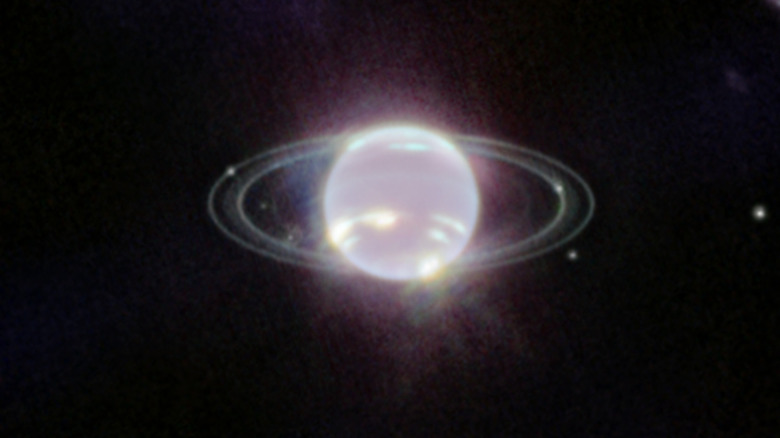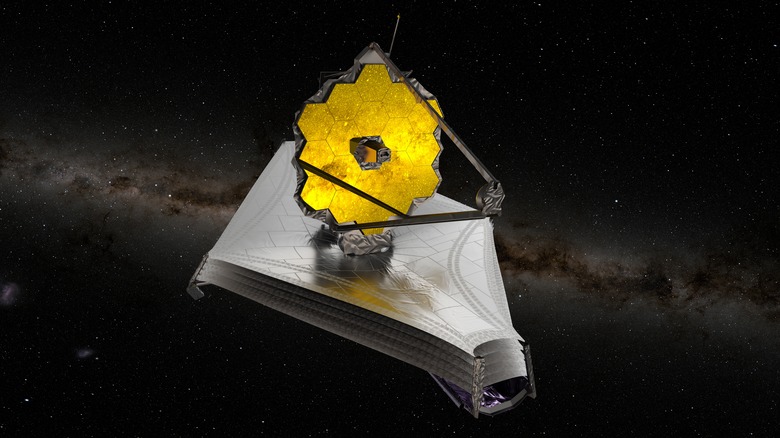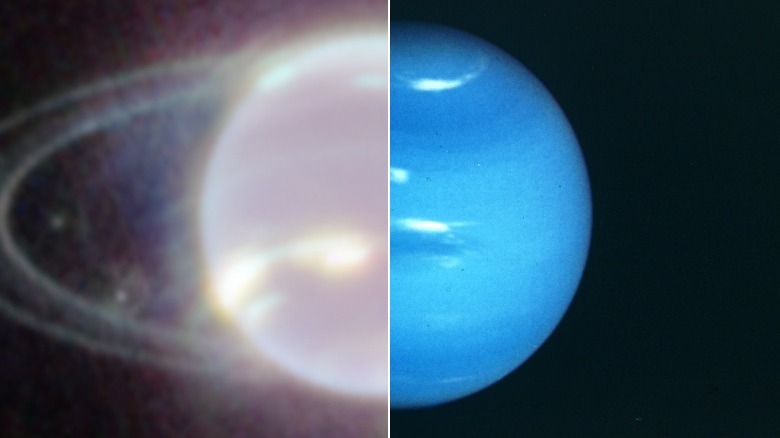NASA Releases A New Glimpse At The Planet Neptune
From NASA and its James Webb Space Telescope (JWST) come new images of Neptune, the eighth planet from our sun. The glowing white representations provide the clearest images of Neptune's rings in 30 years. The JWST is capable of extreme stability and precision, allowing for high-quality image collection. So why does the picture look a bit hazy?
The reason why the beautiful blue planet from our youth isn't presented in these new portraits is because of the type of light the JWST is collecting. These photos compile near-infrared light from Neptune. Webb is a Near-Infrared Camera (NIRCam), and with no blue in that wavelength, we've lost Neptune's famous ocean blue. Its methane clouds instead absorb red and infrared frequencies.
Thanks to JWST's precision, for the first time in infrared, we can see a halo of dust particles interspersed between the more prominent ice rings, producing a feathered glow (via Scientific American). The image data collected "takes all that glare and background away" explains Mark McCaughrean, senior adviser at the European Space Agency, in an article from The Guardian. "The rings are more reflective in the infrared so they're much easier to see." Just like the 1989 flyby of Voyager 2, this new visual data is sure to produce a flurry of new scientific articles within the next year.
The JWST is our new tool for space exploration
The new JWST essentially replaces the Hubble space telescope which has orbited the earth since 1990 (via The Guardian). But instead of an Earth satellite, the JWST orbits the sun. JWST whips around the sun, keeping pace with our planet a million miles from Earth and far off from our moon (via NASA). Much like our moon always has the same side facing Earth, JWST maintains one sun-facing side, creating permanent hot and cold sides of the satellite.
On the hot, 185 degrees Fahrenheit (85 Celsius) side of the satellite, a large "sunshield" blocks the sun. This protects the telescope from light and heat from the sun, Earth, and Earth's moon. Behind this shield, the telescope is protected on the cold, -388 degrees Fahrenheit (-233 Celsius) side. The telescope features signature hexagon plates of beryllium metal collecting various light spectrums. It's an engineering marvel which pushed scientists beyond the previous limits of technology.
Researchers and the public alike have now gazed upon new images of stars being born, dying, and a plethora of stages in between. The Neptune pictures come close on the heels of new exoplanet findings. We now have images of exoplanets, planets outside our solar system, allowing for finer analysis of their atmospheres. Webb scientists predict the ability to detect signatures of Earth-like life. Only recently JWST's focus was pulled from viewing deep space to our closer collection of cosmological companions (via The Guardian).
Neptune is a giant concentration of gas and mystery
The famous space probe Voyager 2 flew by Neptune for only a few hours in 1989. From as little as 3,000 miles away, it collected some of the first brilliant blue images of the planet (via NASA). It took Voyager 2 about 12 years to reach Neptune, orbiting the sun 30 times farther away than Earth. Unlike this relatively close flyby, the JWST is collecting its images from millions of miles away.
The infrared images already offer new insights into the composition of the planet. Neptune is an ice giant composed of only an atmosphere with no solid surface. Clouds of methane ice shift across its face and we can now make out a high-latitude group of clouds around the southern pole (via NASA). But, the JWST has a limited perspective on the planet due to Neptune's 164-year-long orbit. It will be years before we glimpse the northern pole, which emanates an "intriguing brightness" because it's currently tipped away from view.
In wider shots from Webb, what appears like a brilliant start is actually Neptune's huge moon Triton photobombing its planet (via The Guardian). Triton owes its sparkle to a highly reflective surface.
According to USAFacts, $10 billion spent by NASA and possibly $1.1 billion more through 2027, as well as the consortium between the European and Canadian space agencies and NASA, will continue a stream of pretty space pictures and insights into the fundamental nature of the universe.


